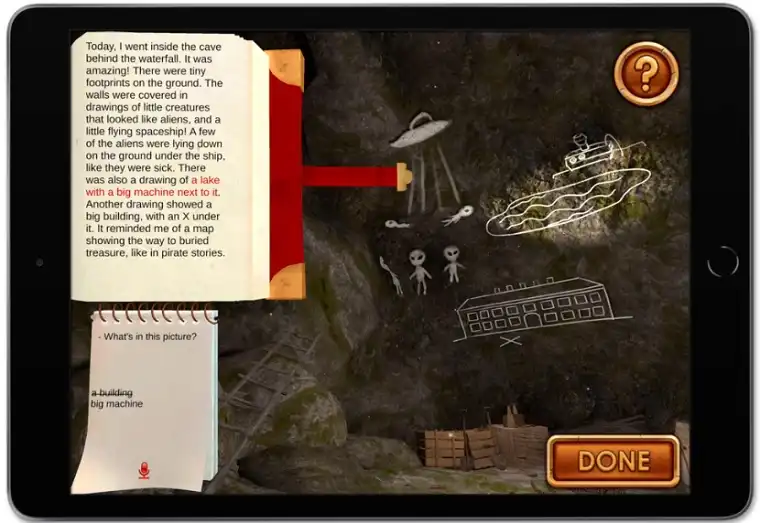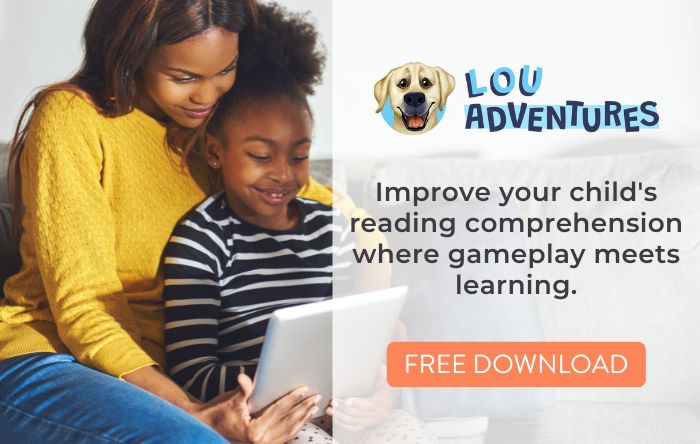Are you looking for some fun reading activities that will get your kids excited about reading?
Just sitting your child in front of a book isn’t enough to cultivate a strong love of reading. You need to make it engaging and fun for them!
Whether you’re a parent, teacher, or homeschooler, there are plenty of creative ways to inspire children to read.
Here are 10 fun reading activities for kids that will get them engaged and motivated to learn:
1. Try the Lou Adventures App
 Lou Adventures: An Interactive Learning Story for Kids
Lou Adventures: An Interactive Learning Story for Kids
Lou Adventures is an interactive learning story for kids that helps them improve their reading skills through a fun, adventurous game.
What if you could make your child’s screen time more productive and more fun? Lou Adventures is an interactive story app that helps kids build reading skills in a fun, engaging way that appeals to their sense of adventure.
What Do You Need?
Internet and Smartphone/Tablet
How To Play?
- Mystery at the Lakehouse by Lou consists of 12 chapters that take you through a world of mysterious activities.
- They develop reading and comprehension abilities while keeping your child hooked to all levels of the game
- Lou asks your child to go through the text before quizzing them on what they’ve read.
- The queries are addressed verbally by your child. In case of a wrong response to a mystery, Lou allows the child to re-read the text to solve the mystery correctly. Reading the passage aloud to your child will help them understand the reading process better and help with pronunciation.
- The app helps kids improve their reading comprehension using speech recognition technology through a fun, interactive game format. It works like a virtual tutor, helping kids improve their reading and pronunciation.
Check out our Lou Adventures review for a full look at the app.
Click here to try Lou Adventures for free!
2. Phonics & Pronunciation Activities
What’s better than your kid learning pronunciation and phonics for fun? Here are two primary activities we recommend for your children’s improvement.
R And R – Repetition And Rhyme
Books become predictable through repetition, and young readers enjoy more about new things.
What Do You Need?
Books with phrase repetitions and rhyming poems
How to Play?
- Choose a poem or a story with recurring phrases that you and your child will enjoy.
- While reading slowly, acknowledge your kids’ participation by grinning or nodding.
- Pause the story as the kids become familiar with it to fill in the blanks quickly.
- Encourage your kids to act out reading, especially for books with repetition.
Hopscotch Spelling Bee
It is best to have a group where everyone can cooperate to complete a single goal.
What Do You Need?
Open space and chalk
How To Play
- Create a hopscotch game in a vast open space with four to five maps, each with seven letters.
- The letters on each child’s hopscotch board must be their own.
- The children now have to cooperate in hopping to the word’s letters in sequential order after they choose a word.
- The child with the letter “a” on their map would have to hop there first if the word was “an apple,” then the child with the letter “p,” who would have to jump twice, and so on.
- Setting a time limit will add to the drama and make things more exciting.
3. Poetry In Motion
Reading is valuable when it is read aloud. Let your kid tell stories and poetries himself.
What Do You Need?
Easy-to-read books, a few accessories, or unique clothing
How To Play
- Choose a book your child typically adores or has read numerous times.
- This might come from one of their course subjects or even a children’s book. Let him create some potential story-related props or dress up as a character.
- Ask your child to plan the act and perform. Don’t forget to have a cheerful mood
- Ask him to incorporate any actions within the story into his narration.
4. What’s In The News?
Kids can read in various ways with “What’s in the News.” There is nothing better than teaching your children to get started with newspapers at an early age. It would be best if you had a collection of newspapers to start with the activity. There are a lot of tips for conducting newspaper activities for your children.
What Do You Need?
Newspapers
How To Play?
- Mark paragraphs in the newspaper and cut them.
- Have your child arrange the paragraphs in the proper order.
- Request that they create a story around newspaper clippings you have cut out.
- Pick out an editorial and let them read it.
- Ask them to perform the role of a newscaster and read you a piece.
5. Using Television To Stimulate Reading
What if I tell you that your TV-addicted children can also learn from TV? Media’s role has become pervasive and contributes to our comprehension skills. Don’t let them become couch potatoes, though! TV can assist kids in expressing their desires, feelings, and vocabulary if parents start watching thoughtful programs.
What Do You Need?
TV
How To Play?
- Encourage your children to focus on the advertisements running on TV.
- Make your predictions.
- Ask your child to describe an issue the show’s lead character had to deal with tonight.
- To learn how the issue was resolved, ask them to explain it. Is there another solution they can think of?
- Help your child retell the story’s key events chronologically by providing a sequencing lesson.
- Sequencing and identifying vital details are two critical comprehension skills here.
- Determine the relationship between a cause and an effect by asking what transpired due to a particular action.
- Ask them to explain the reasons behind a character’s actions. Enquire about their motivations.
- Can your kid come up with a different course of action or resolution? To help your child form opinions, ask them to assess a scene from the show or a character’s behavior.
- Help your child describe the plot, setting, main characters, and favorite parts, just like a teacher would in a book report.
- This is excellent preparation and helps the kid feel more comfortable and at ease when writing a book report for school.
- Discuss the propaganda strategies employed by marketers.
- Exaggeration, product placement, exploitation of social anxiety, celebrity endorsements, and desirable locations should all be explained.
6. Do A Book Scavenger Hunt
It’s an exciting game involving books where puzzles are to be solved using clues to find where books are to be found.
What Do You Need?
Books and Clues
How To Play?
- Parents and all the other players must stop searching and rush to the book if they find one.
- If they sit down immediately and shout, “Book Found!” Everyone stops looking and goes to the book.
- Everyone will hear the book read aloud by the finder or parent.
- Till every book is located and read, the search goes on.
7. Use Word Search Puzzles
When kids get older, they can participate in activities where they have to sort through a bunch of nonsense to find words that they can recognize.
What Do You Need?
An activity book
How To Play?
- Give your child word search puzzles or crosswords that have already been solved.
- Request that he circles with a pencil any particular words he finds in the jumble.
- Remember, only one word is to be searched at a time.
- You can give them a comprehensive list at the outset and let them work through it independently.
8. Utilize The Five Senses
To engage all five senses, create experiences. To give your students a taste of the book, see if you can do something interesting.
Starting with ‘touch,’ you can bring any famous character’s cloth to your kid for touching. It would be better to look for something which your child is familiar with.
For ‘sight,’ there are many options. With videos or images, students can better visualize a setting, person, season, etc.
You can play various sounds for the ‘hearing’ sense for your kids. Allowing students to hear lightning and other stormy sounds creates an illusion of the same. The sensation of smell can be brought by cooking delicious foods or taking them to a garden full of flowers. Isn’t it exciting?
All these ways to use the five senses help your children develop familiarity with their body and ultimately impact cognitive and motor skills.
9. Word-Based Snakes And Ladders
Let’s bring a twist to the usual snake-ladder game, where the numbers are swapped out for simple words. This variant also comes with a unique board that you can buy. Alternatively, you can use a pen and all 100 of the board’s squares for writing easy-to-read words.
What Do You Need?
Snakes and Ladders Board, and a felt pen
How To Play?
- When your child passes each square, he can count them and speak the words out loud.
- Your child can develop word scanning by visual identification and referring to various parts of the board.
10. Play Go Fish!
Playing Go Fish for your child is great fun and the rules are simple to understand. Focus on obtaining 4-of-a-kind matches when playing with 2 to 6 players to be the first player to discard all of their cards. Your child plays each hand in various fun ways, so this traditional card game will never get old for you.
What Do You Need?
Go Fish Cards
How To Play?
- Choose a person to deal with and shuffle the cards for the opening round.
- Pass the cards to each player after the dealer has shuffled them.
- Place the remaining cards upside down in the center of the table.
- The “fishing pond” is thus produced. To prevent peeking, make sure that every card is kept upside down.
- Give the first opportunity to the person seated to the dealer’s left.
- Everyone will eventually get the chance to go first, another benefit of rotating who the dealer is.
Why Is Reading Important For Kids?
A child’s success in school, at work, and in life, in general, is unquestionably influenced by their reading abilities. Furthermore, reading to your child from a young age can help accelerate their success.
1. Cognitive Development
Reading to young children helps with cognitive development. The emergence of thought and comprehension is known as cognitive development. In a nutshell, it is defined as the general mental capability involving reasoning, abstract thinking, analytical and problem-solving, planning, and learning from experience. All these factors influence your child’s brain development and help them become well-rounded individuals.
2. Language Proficiency Development
Starting as early as infancy, reading aloud to young children regularly can aid in developing reading comprehension, collaboration, and interpersonal skills. Reading at an early age stimulates learning in the brain to help with language development. Children will pick words when you read aloud and gradually start speaking on their own.
3. Academic Success Preparation
As you read aloud to your child in the early years, you give your child a genuine one-on-one opportunity to interact. Being exposed to new words helps kids expand their vocabulary. It also helps them develop listening skills crucial for academic success.
4. Relationship Building With Your Child
The most crucial thing you can do to positively affect a child’s development is to spend time with them. Setting up a regular, shared activity connects you to your child. This helps to create a strong, friendship-like bond and gives your child a sense of motivation, belonging and trust.
5. Better Focus And Self-Control
In addition to giving your child quality time, scheduling regular reading time has the added benefit of improving your child’s focus and discipline. Getting young children to concentrate can be challenging because they seldom relax for extended periods.
However, you might notice a change in your kids’ behavior once they are exposed to regular reading. The first few times they hear a story, toddlers create a fuss and may throw tantrums; eventually, once they get the hang of their daily routine, they won’t give you a hard time. Just remain a little patient.
6. An Increase in Imagination and Creativity
Reading as a creative activity can introduce your child to a new world. It can foster an innovative mindset. Your child’s ability to dream big and act creatively will increase as their imagination is continuously evolving, which will benefit them in their future academic and professional endeavors.
Final Thoughts on Reading Activities for Kids
The best way to help your kids fall in love with reading is to make it an enjoyable activity.
Make sure to create a fun and exciting activity by using games, props, and other creative ideas.
No matter how you approach it, make sure to emphasize the importance of reading in your child’s life and also enjoy some quality time together!
Try these reading activities for kids and see for yourself what an amazing difference they can make.
Have any questions about our guide to the best reading activities for kids? Let us know by commenting below.



